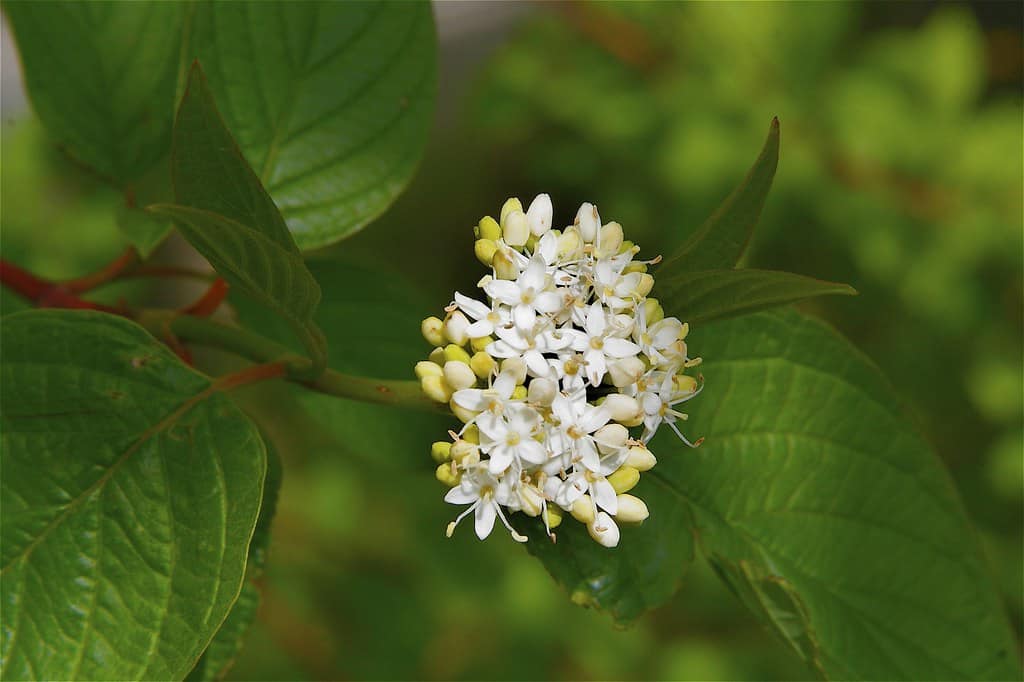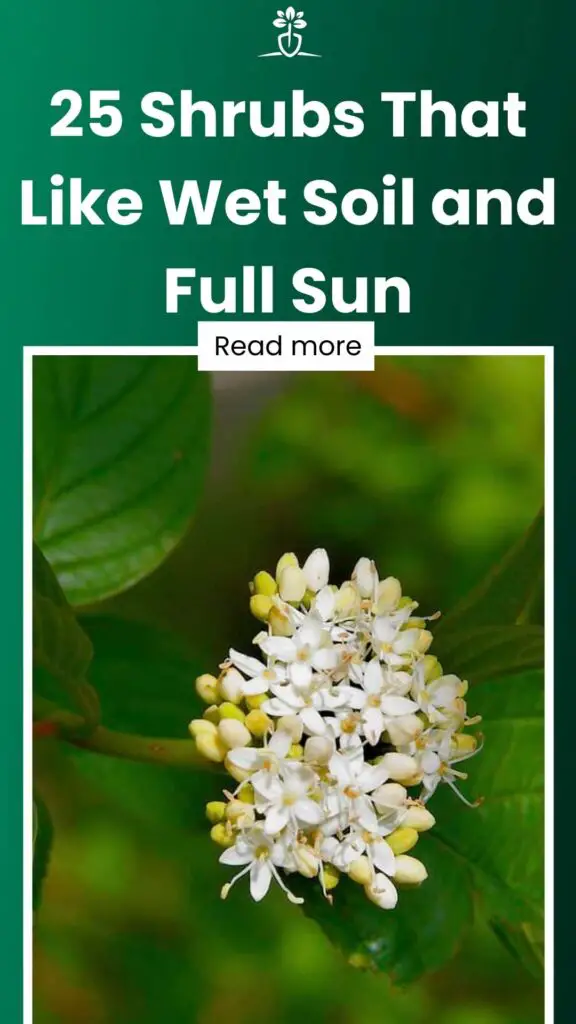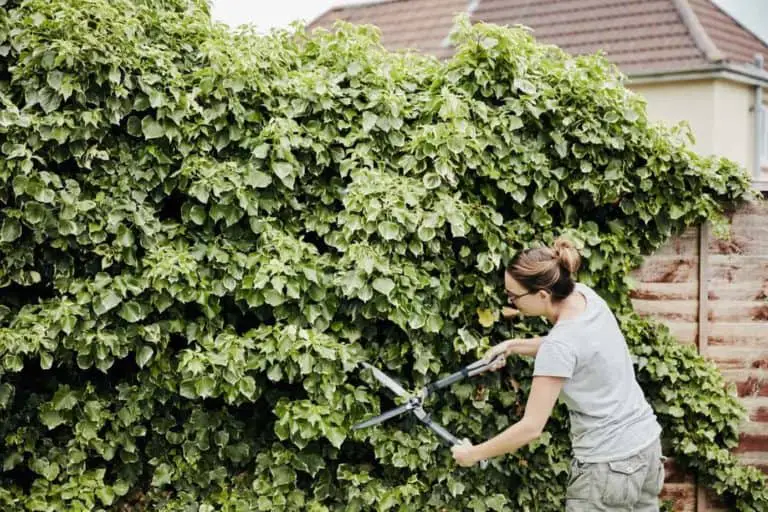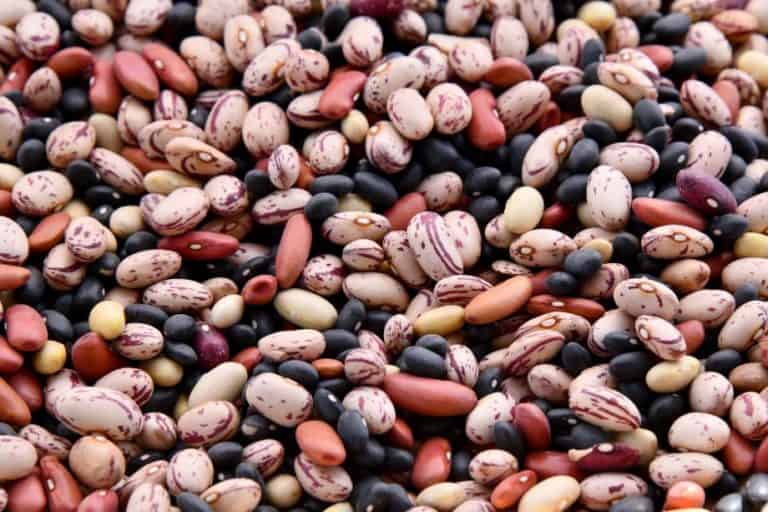25 Shrubs That Like Wet Soil and Full Sun
Living in a super muggy spot or having a garden that’s always sunny but doesn’t drain well can feel like a real jam, right? Take a look at these specially chosen shrubs. They love lots of water and sunshine, and they do great in shady areas too. Just the ticket for those tough spots in your garden!
Let’s look at our list of shrubs that will do well in such an environment.
Contents
1. Red Osier Dogwood

Red osier dogwood takes on the appearance of trees more than shrubs. These ephemeral growths can undergo an extraordinary layout and grow almost twelve feet.
Sow a red osier dogwood if you want to add color and beauty to your terrain throughout the year. Small white berries will appear on the shrub in spring and early summer.
In the fall, you are greeted with colorful leaves from the dogwood’s red branches. That hue of bright red on the bark of red osier dogwood stands out during the winter months.
In addition, because it spreads underground, it is excellent for erosion control.
2. Buttonbush
Buttonbush is a shrub for the marshland. It flourishes in rivers, ponds, and watercourses.
The buttonbush does not grow naturally in the North American Northwest.
However, you will be able to spot its spur clusters in every other place. It can thrive in terrain with some humidity, but it will not survive in an area where there is no water.
Also, bees like this shrub. It makes bulb-like flowers that are nutritious in pollen and nectar. So, if you wish to lure bees to your surroundings, you need to plant the buttonbush.
3. Winterberry
Winterberry shrubs can be prominently found in the soggy parts of Northeastern America. During winter, the female plant will produce reddish berries.
Shrubs grow well in low spots of your yard.
For a beautiful hedge and bird-attracting winter garden, plant them alongside drainage ditches. Winterberry shrubs are healthier than several others, which means you can plant them in soil that drains poorly and still see them flourish.
4. Tatarian Dogwood
As a relative of the red osier dogwood, Tatarian dogwood is native to Asia. This shrub stands out against a winter scape because of its brightly colored bark, like the red osier. During the spring and winter, birds like the berries that are produced by this dogwood.
Plant these shrubs near your windows if you want to attract butterflies. You might end up obscuring your view if you try to see the birds closer by using them as screens.
5. Yaupon Holly
Yaupon Holly can serve as a shrub or tree in your garden. Despite being available in miniature forms, these shrubs can grow up to 45 feet in height. Make sure you do not mix the weeping, columnar, or dwarf varieties at your local nursery.
In the same way as the winterberry, yaupon holly shrubs produce berries through the whole year, but male plants are barren.
If you are a coffee lover, you are in luck. The twigs and leaves that these shrubs produce when they bloom are rich in caffeine.
6. Summersweet
Summersweet, or Clethra alnifolia, is a shrub that can tolerate areas of standing water and still thrive. This is a deciduous shrub that will flower most of the summer with fragrant white blossoms.
Summersweet will survive in limited sunlight.
As with the other shrubs that make our list, it will beautify your landscape.
These shrubs do not reach extraordinary heights, but they are attractive enough to prevent people from looking at your lawn. This shrub’s leaves change color from green to a golden yellow in the fall.
7. Meadow Rue
You are unlikely to have a lot of bare ground to fill with meadow rue. As opposed to its low-growing shape, the shrub boasts a tall, slender shape.
Meadow rue’s purple stems are dotted with tiny lavender flowers in spring and early summer. Eventually, the blooms will fade, and the shrub will take on a lacy teal color.
Humidity and drought are not conducive to the growth of Meadow rue. Sadly, they do poorly when kept inside, so if the climate in your area is not conducive to successful growth, you won’t observe any noticeable results.
8. Sweetspire
For newbie gardeners, sweetspire is a water-loving shrubbery. If you plant them in an area where they will get the right amount of sun exposure, they will bloom and yield lovely white blossoms in the spring.
Although these shrubs do not have a stiff scent, they produce exceptional pollination shrubbery, which is a great plant to grow if you want to repopulate your local bee population.
Apart from pollination, these shrubs also begin to change color in the fall.
Sweetspire’s dagger-like leaves will change from green to red and orange as they turn. Their vibrant color will create a pop of color in your border until those first frosts settle in.
9. Red and Black Chokeberry
Chokeberry (Aronia arbutifolia) is a deciduous, bushy shrub that produces clusters of deep red berries in late spring/early summer. This shrub is suited for slopes and ravines and on moist, well-drained soil.
It can be found in the wild as far north as Canada, west to Arkansas, and north to Minnesota, making it a natural fit for gardens.
Chokeberry enjoys full to part-shade and is rarely found in hot, dry lawns.
10. Sweetshrub
If you’re looking for a shrub that smells great and has brightly colored flowers, then the sweetshrub will do the trick.
This shrub can reach heights of 9 feet, but its spreading is more noteworthy.
If you want to plant a shrub to provide privacy, the sweet shrub has a 12-foot reach.
These shrubs take a long time to grow. This speed varies depending on circumstances, but generally, they grow at about the rate of one. Grow a sweetshrub in partial shade and misty soil to guarantee its healthiest growth.
11. Spicebush
Spicebush is a low-growing shrub that can still provide your home with privacy. Place these in the lower areas of your yard for promising growth.
Again, these shrubbage grow differently depending on gender. You do need male and female spicebush plants to see the females yield fruit.
If you are indifferent to fruit, try introducing male spicebush florae to your greenery. These shrubberies produce larger flowers than their female counterparts. They will also add more beauty to your gardening.
12. Silky Dogwood
One of the most tolerant shrubs is silky dogwood. The plants can grow in both alkaline and clay soil, and they can survive the occasional drought and rare floods.
Shrubs like this one aren’t bulky, so they’re perfect for window decorations. Also, in contrast with the burgundy of their stems, white bundles of flowers are produced.
By planting silky dogwood shrubs in your yard, you’ll attract lots of butterflies and bees.
In their short blooming season between late spring and early summer, these white flowers make enough pollen to sustain an entire insect ecosystem.
13. Inkberry
As a variant of the classic holly bush, inkberries are another common variety. They grow to a maximum height of only 8 feet, considerably shorter than most other similar shrubs.
Unless it drops below zero degrees Fahrenheit, the inkberry holly will not grow leaves over the winter.
They will reproduce their signature green-and-white flowers in the following spring as long as you plant them in inappropriately moist areas.
14. Possumhaw
Possumhaw is best known for its holly family affiliation. A deciduous shrub that grows up to 30 feet tall is more often referred to as a tree. Nonetheless, you can prune it to keep it at a more manageable height.
As the winter approaches, the shrub’s flowers turn into red and blackberries. These berries, however, will only appear on the male of the species, as is the case with quite a few of those on this list.
You will not only attract birds with these berries. Possums and raccoons also enjoy the shrub, which is why it is called possumhaw.
Although, if these pests aren’t common in your region, then you won’t need to worry about them affecting your landscape.
15. Laurel
As with many other moisture-loving shrubs, Laurel thrives in moist soil and reaches a maximum height of 16 feet. By looking at the shrub’s tiny, yellow flowers, you can identify whether the laurels in your yard are healthy.
Therefore, you should not be too concerned about their health.
As long as they are well-cared for, these shrubs can survive short bursts of heat and drought.
16. Arrowwood Viburnum
Its ever-changing color makes this shrub a favorite among homeowners. Summer is the perfect time for arrowwood viburnums to grow green, but come fall, they will turn yellow and purple.
Additionally, you can grow Arrowwood viburnums to attract butterflies to your garden.
Butterfly species of all types can take advantage of their pollination abilities to avoid hunger and live out their cycles or make it through migration safely.
In the summer, birds love to snack on the blackberries that this shrub produces.
17. Swamp Azalea
Clammy azaleas, as they are called, are shrubs that don’t grow tall. Although swamp azaleas can grow up to 12 feet wide, they grow slowly.
This shrub will begin to change color in the fall, becoming a deep green, orange, and purple-red. As well as producing white and sweet-smelling flowers throughout the springtime, swamp azaleas give your landscape some additional color.
18. Cranberry Bush
If not observed closely, some Cranberry bushes resemble maple trees. In spring, this shrub will bear white flowers. Red cranberries can be harvested in the summer, while you’ll have to be careful not to eat pesticide-treated cranberries.
Cranberries are high in fiber, manganese, and. Vitamin C.
19. Barberry
Barberries are deer-resistant because they love moisture, so their vibrant colors are sure to last a long time. Leaves will fall off the shrubs in the winter.
While their red blossoms can be enjoyed during other seasons, their purple hues are most attractive.
Interestingly, barberry is medicinal and poisonous.
Aside from its fruit and seeds, the plant contains berberine, a poison that also has therapeutic benefits.
20. Highbush Blueberry
Do you want to plant a shrub that’ll provide more than just birds with food? In the late summer months, you can enjoy a snack while enjoying the privacy of the highbush blueberry shrub.
Highbush blueberry bushes will not flourish on clay soil.
Hence people living on top of clay soil cannot grow blueberries.
21. Deutzia ‘Strawberry Fields’
The Deutzia ‘Strawberry Fields’ cultivar has a graceful, arching habit and is a deciduous variety. The flowers on this plant are clustered into small clusters, and their centers are pale pink but flush to magenta on the outside.
Also, the flowers smell sweet. This shrub looks great on a shrub border or as a specimen shrub where you can admire its flowers thoroughly.
Deutzia ‘Strawberry Fields’ does best when planted in fertile, neutral to alkaline soil in a sunny to a partly shady location.
Remove the stems to promote healthy growth and hard-prune flower stems when they bloom.
22. Pussy Willow (Salix discolor)
There are swamps and meadows throughout North America that contain pussy willows, as well as streams and lakes. The plant also tolerates dry soil to some extent.
They grow between 6 and 15 feet tall and spread between 4 and 12 feet wide in the right conditions.
Pruning should be done in the late winter or early spring as necessary.
23. Pigsqueak (Bergenia cordifolia)
As a ground cover, Pigsqueak thrives as a perennial. Rub its leaves between your fingers, and a squeaking noise will be heard. The height and spread of the plant are approximately one to one and a half feet.
The plant includes both the ability to tolerate wet soil and the ability to grow in the shade. Late winter or early spring is the best time to prune damaged, dead, or diseased foliage.
To encourage more blooming, remove spent flowers as soon as they appear in spring.
24. Sweet Pepperbush (Clethra alnifolia)
It grows along wet streams, marshes streams, and wetlands and beach shorelines. This plant stands 3 to 8 feet high with a spread of 4 to 6 feet.
Flowers spike out during summer, attracting butterflies and bees.
It is vital to water your shrubs regularly to ensure the soil remains moist.
Pruning should be done at the end of the winter season.
25. Leopard Plant
In rain gardens and around water features, the leopard plant is an excellent choice. In early summer, its showy yellow-orange flowers are like daisies.
There are also some green tones to the large leaves. The plant only reaches a height of around 2 to 3 feet, with a spread of about 1 foot.
Keep the soil moist by watering regularly and deeply.
In hot weather, it should also have some shade.
There you have it; our list of the 25 Shrubs that like wet soil and full sun. We hope that you find something on our list that you would like to add to your landscape.



